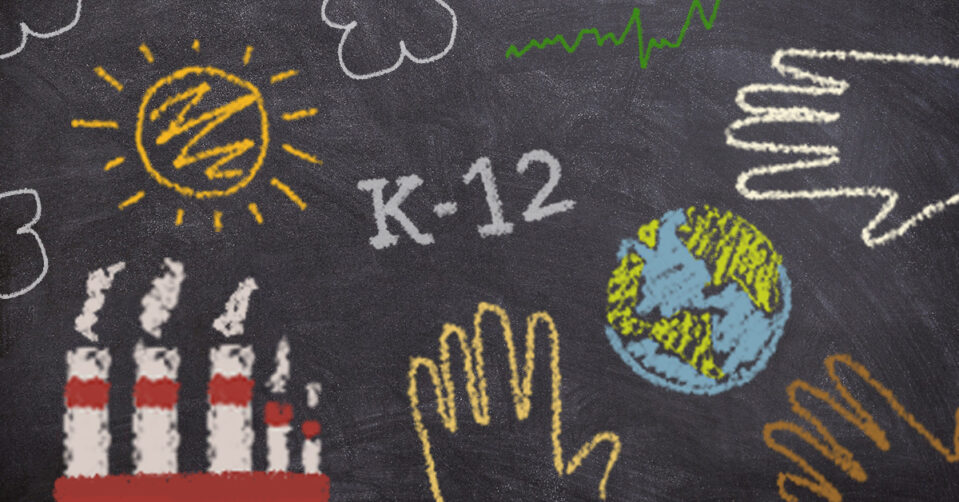States Face Learning Curve on K-12 Climate Curriculum
Rachel Ramirez-Guest (Staff Attorney II) / February 9, 2023

Though climate change has the potential to affect the lives of most school age children today, a recent study shows that schools do not have a standard curriculum on the topic. In a study by the North American Association for Environmental Education (NAAEE), which analyzes publicly available K-12 education policies (e.g., state curriculum frameworks, standards, environmental literacy plans, etc.) across all 50 states and D.C., the authors find that most policies do not talk about the causes of climate change, while nearly a third suggest that human behavior has not contributed to climate change. The study further finds that education policies across the country largely exclude discussion of climate justice, Indigenous knowledge or priorities on climate, or climate action more generally (including mitigation and adaptation). For example, study authors found that only two states discussed climate in relation to justice at all. The study authors argue that an effective climate curriculum should go beyond merely teaching causes and effects of climate change in science classes. Encouraging students to engage with social, emotional, and action-oriented climate considerations through a justice lens has a place in other subjects, such as social studies. An interdisciplinary approach to teaching youth about climate change can help develop important skills such as “civic engagement [and] leadership, interpersonal, decision-making, media-literacy, and critical thinking.” The study further suggests that greater consideration of climate in K-12 education policy can help to “address climate-related mental and social health issues” students may be experiencing.
The study recommends several ways states can address the pedagogical needs raised by climate change through their education policies, inside the classroom and beyond. These include strengthening curricula and learning standards, and improving resources and training for educators—as several states are working to do. For example, Connecticut and New Jersey have recently strengthened and standardized climate change education in their states.
Connecticut now requires all state public schools to teach 5th to 12th grade students about the science of climate change causes and effects according to the Next Generation Science Standards beginning in July 2023. The Connecticut Board of Education had recommended schools follow the guidelines since 2015, and E&E reports that Connecticut’s recent law marks the first state law mandating use of these standards (which are currently only taught to approximately 37% of U.S. public school students). The move will ensure that climate science is taught more consistently across the state, and that climate education is protected against future budget cuts, the Guardian reports. While Connecticut law only requires climate education in science courses, rather than the interdisciplinary approach encouraged by the NAAEE study, this CT Mirror report notes that the Next Generation Science Standards develop students’ understanding and ability to discuss the causes and potential solutions to climate change. See, for example, this lesson plan which asks middle school students to come up with ways to minimize human impact on the environment.
New Jersey adopted its own climate learning standards for 5th to 12th grade students in 2020, which are interdisciplinary—incorporating climate change content into science and social studies courses, as well as other subjects such as the arts, computer sciences, languages, health, and career readiness. According to this ABC News report, implementation of the standards was delayed due to the pandemic, but in 2022 New Jersey allocated $5 million dollars toward implementing its standards. The state has launched a climate education hub with training and resources to aid educators in carrying out the climate learning standards.
Beyond the classroom, the NAAEE study recommends states make changes to institutional governance and operations in their education sector to both model and address the issues raised by a changing climate. Examples include: Tennessee’s Energy Efficient Schools Initiative (which funds energy efficiency projects for K-12 schools) and Rhode Island’s school-as-a-tool program (which teaches students about sustainability by using school facilities and operations as a laboratory to study, plan, and implement sustainability measures).
There are some states where this topic has presented challenges and the NAAEE study specifically points out that there are political pressures targeting social justice curricula, which “may further impede climate justice education.” But the education system is where students learn skills and basic information needed to succeed in society today. This new study offers a look at the role of schools in teaching about sustainability and climate science through learning frameworks that can prepare the next generation for the challenges and opportunities ahead.
This page was updated on April 2, 2024 to better meet our accessibility standards. To see the page as it was initially published, click here.
